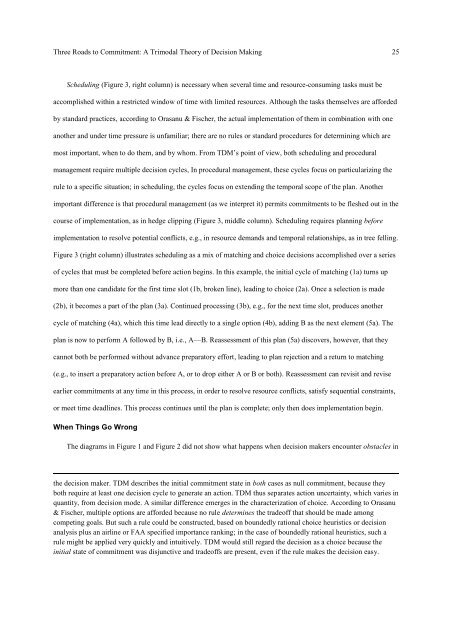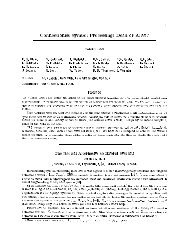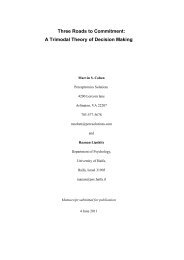Three Roads to Commitment: A Trimodal Theory of Decision Making
Three Roads to Commitment: A Trimodal Theory of Decision Making
Three Roads to Commitment: A Trimodal Theory of Decision Making
You also want an ePaper? Increase the reach of your titles
YUMPU automatically turns print PDFs into web optimized ePapers that Google loves.
<strong>Three</strong> <strong>Roads</strong> <strong>to</strong> <strong>Commitment</strong>: A <strong>Trimodal</strong> <strong>Theory</strong> <strong>of</strong> <strong>Decision</strong> <strong>Making</strong> 25<br />
Scheduling (Figure 3, right column) is necessary when several time and resource-consuming tasks must be<br />
accomplished within a restricted window <strong>of</strong> time with limited resources. Although the tasks themselves are afforded<br />
by standard practices, according <strong>to</strong> Orasanu & Fischer, the actual implementation <strong>of</strong> them in combination with one<br />
another and under time pressure is unfamiliar; there are no rules or standard procedures for determining which are<br />
most important, when <strong>to</strong> do them, and by whom. From TDM’s point <strong>of</strong> view, both scheduling and procedural<br />
management require multiple decision cycles, In procedural management, these cycles focus on particularizing the<br />
rule <strong>to</strong> a specific situation; in scheduling, the cycles focus on extending the temporal scope <strong>of</strong> the plan. Another<br />
important difference is that procedural management (as we interpret it) permits commitments <strong>to</strong> be fleshed out in the<br />
course <strong>of</strong> implementation, as in hedge clipping (Figure 3, middle column). Scheduling requires planning before<br />
implementation <strong>to</strong> resolve potential conflicts, e.g., in resource demands and temporal relationships, as in tree felling.<br />
Figure 3 (right column) illustrates scheduling as a mix <strong>of</strong> matching and choice decisions accomplished over a series<br />
<strong>of</strong> cycles that must be completed before action begins. In this example, the initial cycle <strong>of</strong> matching (1a) turns up<br />
more than one candidate for the first time slot (1b, broken line), leading <strong>to</strong> choice (2a). Once a selection is made<br />
(2b), it becomes a part <strong>of</strong> the plan (3a). Continued processing (3b), e.g., for the next time slot, produces another<br />
cycle <strong>of</strong> matching (4a), which this time lead directly <strong>to</strong> a single option (4b), adding B as the next element (5a). The<br />
plan is now <strong>to</strong> perform A followed by B, i.e., A—B. Reassessment <strong>of</strong> this plan (5a) discovers, however, that they<br />
cannot both be performed without advance prepara<strong>to</strong>ry effort, leading <strong>to</strong> plan rejection and a return <strong>to</strong> matching<br />
(e.g., <strong>to</strong> insert a prepara<strong>to</strong>ry action before A, or <strong>to</strong> drop either A or B or both). Reassessment can revisit and revise<br />
earlier commitments at any time in this process, in order <strong>to</strong> resolve resource conflicts, satisfy sequential constraints,<br />
or meet time deadlines. This process continues until the plan is complete; only then does implementation begin.<br />
When Things Go Wrong<br />
The diagrams in Figure 1 and Figure 2 did not show what happens when decision makers encounter obstacles in<br />
the decision maker. TDM describes the initial commitment state in both cases as null commitment, because they<br />
both require at least one decision cycle <strong>to</strong> generate an action. TDM thus separates action uncertainty, which varies in<br />
quantity, from decision mode. A similar difference emerges in the characterization <strong>of</strong> choice. According <strong>to</strong> Orasanu<br />
& Fischer, multiple options are afforded because no rule determines the trade<strong>of</strong>f that should be made among<br />
competing goals. But such a rule could be constructed, based on boundedly rational choice heuristics or decision<br />
analysis plus an airline or FAA specified importance ranking; in the case <strong>of</strong> boundedly rational heuristics, such a<br />
rule might be applied very quickly and intuitively. TDM would still regard the decision as a choice because the<br />
initial state <strong>of</strong> commitment was disjunctive and trade<strong>of</strong>fs are present, even if the rule makes the decision easy.




